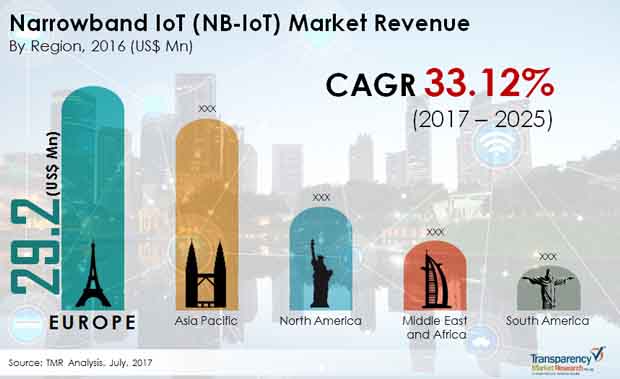Narrowband IoT (NB-IoT) Market Report Covers Detailed Industry Scope, Future Scenario And Elaborates Outlook To 2030
Increases number of competitors to encourage competition in the global narrowband IoT (NB-IoT) market. Key players are deploying this technology to provide faster services to their customers and to gain competitive edge. Some of the noticeable players in the global narrowband IoT (NB-IoT) market are Quectel Wireless solutions Co. Ltd., Vodafone Group plc, u-blox, Etisalat Corporation, Huawei Technologies Co. Ltd., Nokia Corporation, and China Unicom.
Leading players in the market are engaged in strategic decisions such as collaboration, partnership, expansion, and mergers. For example, China Unicom partnered with Huawei to launch NB-IoT based smart parking solution. This partnership will improve the operation management capabilities and efficiency in Shanghai. Other companies are also using this technology in areas and applications.
Significant growth in IoT connections and applications, there are high chances of growth in the global narrowband IoT market. This market is expected to rise at staggering CAGR of 33.12% over the projected period 2017 to 2025. If the market see the growth at this rate, the market valuation is likely to reach US$1.05 bn by 2025.
For More Info | Download PDF Brochure, Click Here: https://www.transparencymarketresearch.com/sample/sample.php?flag=B&rep_id=13715
Application of narrowband IoT is widely seen in comprise smart agriculture, smart bicycles, smart wearable, smart kids monitoring solutions, engineering truck predictive maintenance solution, logistics and container tracking, and pollution monitoring. Regionally, Europe is likely to be at the forefront in driving demand in the global narrowband IoT market. However, Asia Pacific is also expected to contribute in expanding this market. Increasing investment in development of smart cities in emerging economies has further augmented demand in this market.

Easy Compatibility with Existing Cellular Networks to Expand Market Performance
Globally, the demand narrowband IoT technologies have grown significantly due to its rising application in multiple industries. In addition, high-end network coverage and increased security over LTE cellular technology are expected to further accelerate growth in this market. Narrowband IoT support key and prevalent chipset, mobile equipment, and module manufacturers. It also co-exists efficiently with 3G, 2G, and 4G mobile networks.
Other advantages of using narrowband IoT are its lower component cost, low power consumption, and easy deployment into existing cellular networks. Moreover, it provides increased network security, reliability, and excellent extended range in buildings and underground. Adding further, increasing deployment of intelligent devices and increasing need for connectivity in IoT applications might trigger growth in the global narrowband IoT market. Demand for narrowband IoT is growing in automotive industry, as there is high demand for telematics, navigation, and infotainment services.
Request For Covid19 Impact Analysis Across Industries And Markets – https://www.transparencymarketresearch.com/sample/sample.php?flag=covid19&rep_id=13715
Deployment Issues Might Deter Demand for Narrowband IoT
Despite the growing demand for narrowband IoT, few restraining factors might hinder the growth in the global narrowband IoT market. One of the major factors restricting growth of narrowband IoT is transformation downtime while up gradating existing base stations. Additionally, increasing competition from rival LPWAN technologies is also expected to hamper market’s performance. Uncertainty of pricing models and deployment issues also needs to be considered. However, significant rise in smart cities projects and growing initiatives for smart building are expected to reduce the effect of these restraints. Moreover, growing need for connectivity in IoT applications will also fuel growth in the global narrowband IoT market.
The study presented here is based on a report by Transparency Market Research (TMR) titled “Narrowband IoT (NB-IoT) Market (Component – Hardware (Module), Software and Services; Application – Smart Metering, Asset Tracking, Alarms & Event Detectors, Smart Parking, and Smart Bins; End-use Industry – Healthcare, Retail, Energy & Utilities, Transportation & Logistics, Agriculture, and Smart Cities) – Global Industry Analysis, Size, Share, Growth, Trends, and Forecast 2017 – 2025”.
The global narrowband IoT (NB-IoT) market is segmented based on:
Component
- Hardware
- Module
- Others
- Software
- Services
Application
- Smart Metering
- Asset Tracking
- Alarms & Event Detectors
- Smart Parking
- Smart Bins
- Others
End-use Industry
- Healthcare
- Retail
- Energy & utilities
- Transportation & logistics
- Agriculture
- Smart Cities
- Others
Regional
- North America
- U.S.
- Rest of North America
- Europe
- France
- U.K.
- Spain
- Germany
- Italy
- Rest of Europe
- Asia Pacific
- China
- Japan
- ASEAN
- Rest of Asia Pacific
- Latin America
- Brazil
- Rest of Latin America
- Middle East & Africa (MEA)
- GCC
- South Africa
- Rest of MEA
Customization of the Report: This report can be customized as per your needs for additional data or countries. – https://www.transparencymarketresearch.com/sample/sample.php?flag=CR&rep_id=13715
Contact
Transparency Market Research
State Tower,
90 State Street,
Suite 700,
Albany NY – 12207
United States
USA – Canada Toll Free: 866-552-3453
Email: sales@transparencymarketresearch.com
Website: https://www.transparencymarketresearch.com
Comments
Post a Comment